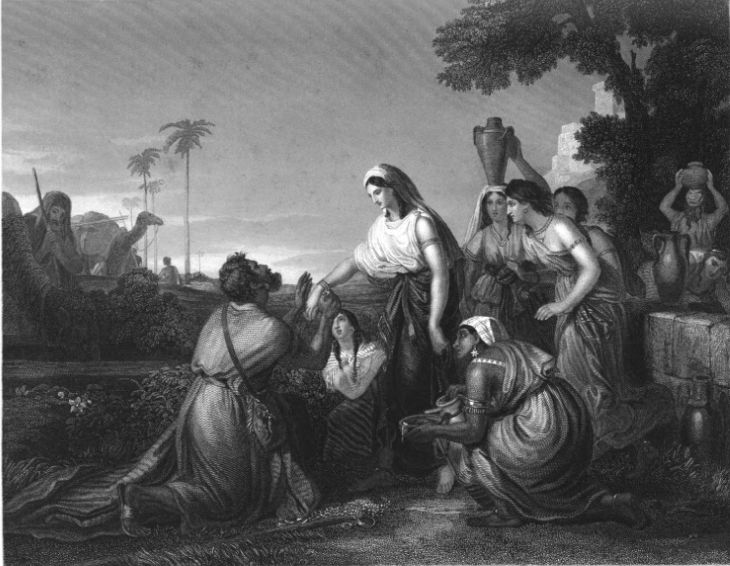
Rebekah at the Well. W. Hilton, R.A., Painter. C. Rolls Engraver. 43 x 32 inches. Source: 1851 The Art-Journal [Click on image to enlarge it.]
Commentary by The Art-Journal
It argues but little in favour of the taste of the period when Hilton lived, to know that a painter endowed with such genius as his, should rarely have received a commission for a picture, and almost as rarely have failed in finding a purchaser for one executed in the hope of a sale. Yet so it was, the best historical painter of his time—and we affirm this without any disparagement to his contemporaries, many of whom were artists of great talent, and entitled to high position—exhibited his works for the gratification of thousands, but seldom to his own pecuniary profit.
Mr. Vernon formed an honourable exception to the Art-patrons of the day, by giving Hilton a commission for a work, when the artist painted the picture from which our engraving is taken. The passages in Scripture here illustrated are in Genesis, chap, xxiv., verses 22 and 47 :—" And it came to pass, as the camels had done drinking, that the man took a golden ear-ring of half a shekel weight, and two bracelets for her hands of ten shekels weight of gold,"—and he "put the ear-ring upon her face, and the bracelets upon her hands." The treatment of this subject is simple, but the simplicity is that of no common mind there is a studied yet perfectly natural elegance in every figure of the composition. The first which would, as a matter of course, be looked for, is Rebekah, receiving, with all modesty and humility, the gifts sent by her future father-in-law; this is, in all points, a very beautiful conception. The next is the "eldest servant" of Abraham's house, one whose fidelity to his master's interests has doubt- less long been tried; he is kneeling, not so much that he might thereby the more conveniently adorn the " damsel," but from respect to her, and because his mission had found favour in her sight, therefore "he bowed his head and worshipped the Lord." The group of water-bearing maidens is charmingly composed, each so well expressing the particular emotion of surprise, or pleasure, or curiosity, by which she is animated. The camels and their drivers, to the left, sustain the balance of the composition, while the lofty palm-trees are cleverly introduced to break the line of the figures and to impart distance.
The colour of the picture is brilliant, though somewhat subdued; the time being "eventide," gave the painter an opportunity of investing it with a warm, sunny glow. It is painted in a vehicle which, for the sake of the artist's enduring fame, we hope will long stand the test of time, for it is undoubtedly one of his best works. Mr. Rolls has engraved it with much delicacy and power. [96]
Image capture and formatting by George P. Landow. [You may use this image without prior permission for any scholarly or educational purpose as long as you (1) credit the Hathi Trust Digital Library and the University of Michigan and (2) link your document to this URL in a web document or cite the Victorian Web in a print one.it
Bibliography
“The Vernon Gallery: Rebekah at the Well.” Art Journal (1851): 96. Hathi Trust Digital Library version of a copy in the University of Michigan Library. Web. 28 July 2013.
Last modified 2 August 2013